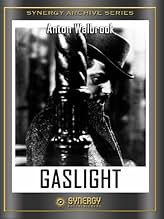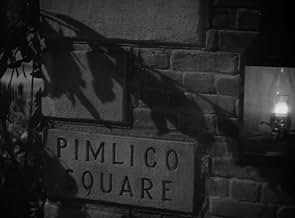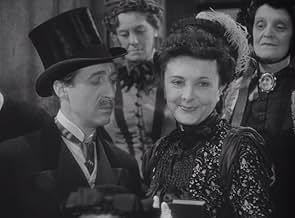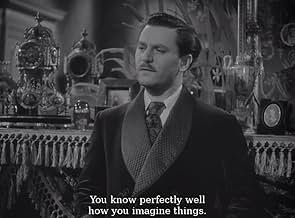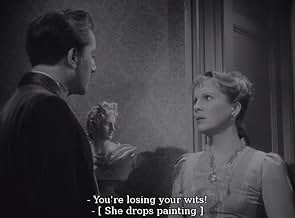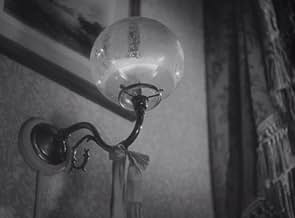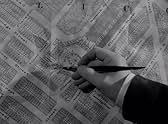NOTE IMDb
7,3/10
5,7 k
MA NOTE
Vingt ans après le meurtre d'Alice Barlow, sa maison est enfin de nouveau occupée. Cependant, le mari du couple qui a emménagé a un secret qu'il est prêt à tout pour garder caché.Vingt ans après le meurtre d'Alice Barlow, sa maison est enfin de nouveau occupée. Cependant, le mari du couple qui a emménagé a un secret qu'il est prêt à tout pour garder caché.Vingt ans après le meurtre d'Alice Barlow, sa maison est enfin de nouveau occupée. Cependant, le mari du couple qui a emménagé a un secret qu'il est prêt à tout pour garder caché.
- Réalisation
- Scénario
- Casting principal
Alfred Atkins
- Bit Role
- (non crédité)
Edwin Ellis
- Bit Role
- (non crédité)
Kathleen Harrison
- Bit Role
- (non crédité)
Katie Johnson
- Alice Barlow's Maid
- (non crédité)
Molly Raynor
- Bit Role
- (non crédité)
Avis à la une
In Victorian London, Louis Bower (Walbrook), murdered his aunt for her precious rubies that are hidden somewhere in her house, only he couldn't find them. Having eluded the police for a number of years and changed his name to Paul Mallen, he takes a wife in the fragile Bella (Wynyard), and the couple move back into the house so that he can continue his search under cover as a respectable Victorian husband. At the same time he tries to drive his wife out of her mind because he is afraid that she might discover his guilty secret...
The first film version of Patrick Hamilton's successful stage play is technically modest compared to the 1944 Hollywood remake (see my review), but this British National production directed by Thorold Dickinson creates an atmosphere of genuine electric tension that Hollywood could only envy. Hardly surprising really that they tried to destroy the negative of this picture. Fortunately prints have survived and it often turns up on TCM every few months. Good performances too, especially from Walbrook who portrays the villain as a vile Victorian bully whereas Charles Boyer played it smooth. Wynyard does well as the tortured wife while Cathleen Cordell is fine as the tarty parlour maid whom Walbrook uses to add insult to his wife's injury.
The film was available in the UK on VHS but it has since been deleted, although the Hollywood version is out on DVD. Let's hope this version finds it's way on to DVD too.
The first film version of Patrick Hamilton's successful stage play is technically modest compared to the 1944 Hollywood remake (see my review), but this British National production directed by Thorold Dickinson creates an atmosphere of genuine electric tension that Hollywood could only envy. Hardly surprising really that they tried to destroy the negative of this picture. Fortunately prints have survived and it often turns up on TCM every few months. Good performances too, especially from Walbrook who portrays the villain as a vile Victorian bully whereas Charles Boyer played it smooth. Wynyard does well as the tortured wife while Cathleen Cordell is fine as the tarty parlour maid whom Walbrook uses to add insult to his wife's injury.
The film was available in the UK on VHS but it has since been deleted, although the Hollywood version is out on DVD. Let's hope this version finds it's way on to DVD too.
Let's face it - the British do psychological suspense VERY well! This 1940 British production is more streamlined and suspenseful than the MGM version of 1944, as it sticks more closely to Patrick Hamilton's play. The MGM version had more 'back-story' and padding to it. I love Diana Wynyard - she was lovely to look at and seemed wonderfully edgy and vulnerable - I wasn't surprised to learn that she played the anguished mother in the West End production of THE BAD SEED - she's really only remembered today for this film and CAVALCADE (1933), but she's definitely worth watching. Anton Walbrook is a little hammier than Boyer was, and there are those obvious streaks in his hair to make him look a little older - but he has a wonderful moment at the films end when, quite suddenly, his eyes go wild and you can tell that he's completely lost his mind - might have been a nice touch if the 1944 had included such a moment. Highly recommended.
I've noticed that people seem surprised that MGM attempted to suppress the 1940 British version of GASLIGHT to avoid any competition with their version. I don't know why anyone should be surprised - Hollywood's business is a cut-throat one: remember that L.B. Mayer, along with Jack Warner and others, offered to buy CITIZEN KANE from RKO and then destroy it, all to appease William R. Hearst - fortunately they didn't (just imagine the history of film since 1941 if they had!) And although MGM didn't destroy all prints of GASLIGHT, they did manage to keep it out of sight for many years - I think I first saw it on a cable station in the early 1980s - I tuned in expecting Boyer and Bergman and got Walbrook and Wynyard - as it turned out I didn't mind at all, and have enjoyed it many times since! MGM did the same thing with Paramount's 1932 DR. JEKYLL AND MR. HYDE which, except for an occasional screening, went unseen (but much written about) until it came out on video around 1990 (under the MGM label - imagine that!)
I've noticed that people seem surprised that MGM attempted to suppress the 1940 British version of GASLIGHT to avoid any competition with their version. I don't know why anyone should be surprised - Hollywood's business is a cut-throat one: remember that L.B. Mayer, along with Jack Warner and others, offered to buy CITIZEN KANE from RKO and then destroy it, all to appease William R. Hearst - fortunately they didn't (just imagine the history of film since 1941 if they had!) And although MGM didn't destroy all prints of GASLIGHT, they did manage to keep it out of sight for many years - I think I first saw it on a cable station in the early 1980s - I tuned in expecting Boyer and Bergman and got Walbrook and Wynyard - as it turned out I didn't mind at all, and have enjoyed it many times since! MGM did the same thing with Paramount's 1932 DR. JEKYLL AND MR. HYDE which, except for an occasional screening, went unseen (but much written about) until it came out on video around 1990 (under the MGM label - imagine that!)
Gaslight (1940) In 1944, MGM released a movie about a thief who slowly tries to drive his wife insane in order to find out the location of some jewels. The movie was called Gaslight, and it starred Charles Boyer and Ingrid Bergman. But the movie wasn't an MGM original by any means; its antecedent was a much-lesser-known 1940 British film by the same name. (Apparently, when MGM bought the rights to the story, based on a play by Patrick Hamilton, the studio attempted to destroy all existing prints of the earlier version, but they weren't successful.) In the opening scene, an old woman is strangled to death, and her killer ransacks her apartment in search of... well, something. His search is apparently fruitless. Years later, Paul Mallen (Anton Walbrook), a debonair society lord in London, moves with his wife Bella (Diana Wynyard) to the posh Pimlico Square, directly below the apartment of the murdered. Mrs. Mallen is quickly the talk of the neighborhood - she's a little off, they say. Something's not quite right with her. And those wags are right; Bella is constantly accused by her husband of stealing things from him, although she has no recollection of the events.
Mallen uses trick after psychological trick against his wife, although it's unclear to the audience what his motives are. Is he just playing with her? Does he merely delight in her anguish? He even deliberately keeps her from her cousin, a man who'd stood against their marriage at the wedding ceremony. What's Mallen's angle? Unlike its remake, this earlier version is delightfully understated - and bereft of stars whose names would be recognizable in the United States. It's remarkably well lit, too, typical for movies of the period. But where it draws most of its strength is from the two leads. Walbrook, who by that time had been in motion pictures for 25 years, is perfect as the sly, debonair, and viciously evil Mallen; Wynyard exudes vulnerability and panic; her Bella is terrified that she might be quite sincerely insane, vacillating from dignified serenity to sheer panic.
This movie is highly recommended to fans of noir film, particularly those who've seen the more-famous 1944 Hollywood version.
Mallen uses trick after psychological trick against his wife, although it's unclear to the audience what his motives are. Is he just playing with her? Does he merely delight in her anguish? He even deliberately keeps her from her cousin, a man who'd stood against their marriage at the wedding ceremony. What's Mallen's angle? Unlike its remake, this earlier version is delightfully understated - and bereft of stars whose names would be recognizable in the United States. It's remarkably well lit, too, typical for movies of the period. But where it draws most of its strength is from the two leads. Walbrook, who by that time had been in motion pictures for 25 years, is perfect as the sly, debonair, and viciously evil Mallen; Wynyard exudes vulnerability and panic; her Bella is terrified that she might be quite sincerely insane, vacillating from dignified serenity to sheer panic.
This movie is highly recommended to fans of noir film, particularly those who've seen the more-famous 1944 Hollywood version.
What a crisp, deeply rooted thriller Thorold Dickinson created. With vile creatures (Paul) and goofy policemen and maids, we are easily captured into the world of the Mallens. Diana Wynyard does a spectacular job as Bella, giving us the right amount of insecurity coupled with fear. She is the true victim of this film and Dickinson does not let us forget that. Wynyard is nearly overshadowed by my favorite character of the film, Paul Mallen, played with so much evil by Anton Walbrook. I have seen several films in my life, and I must say that Walbrook ranks among some of the most sinister villains of them all. He has no super powers, just the ability to manipulate Bella mentally, proving that he is stronger than her. He thrives on Bella's insecurities and makes them into his greatest form of punishment. These two working together really transformed this 40s thriller into something concrete and powerful. It is the dynamic between the two that kept me glued to my seat and continually asking for more.
Coupled with the superb acting is the creativeness of Dickinson and his writer A.R. Rowlinson. Together they set the mood with darkened corners and alleyways with that constantly looming feeling that the events are going to get grittier down the road. This team made Victorian London a spooky place to visit at night. They make Bella the victim throughout this entire film, making even me wonder if she really was slowly going mad. It isn't until the end that the truth is revealed and even then we are left in suspense. It isn't until the credits roll is the film over, and that is hard to accomplish for directors of the thriller genre today. Dickinson proved that he could handle all the elements with the greatest of ease and bring them to the screen in a film that would last the test of time. I am not embarrassed to show this film to friends because I do believe that they would see the value in this production.
Grade: ***** out of *****
Coupled with the superb acting is the creativeness of Dickinson and his writer A.R. Rowlinson. Together they set the mood with darkened corners and alleyways with that constantly looming feeling that the events are going to get grittier down the road. This team made Victorian London a spooky place to visit at night. They make Bella the victim throughout this entire film, making even me wonder if she really was slowly going mad. It isn't until the end that the truth is revealed and even then we are left in suspense. It isn't until the credits roll is the film over, and that is hard to accomplish for directors of the thriller genre today. Dickinson proved that he could handle all the elements with the greatest of ease and bring them to the screen in a film that would last the test of time. I am not embarrassed to show this film to friends because I do believe that they would see the value in this production.
Grade: ***** out of *****
I have liked the Gaslight films for many years and was surprised and delighted recently to find both versions together on an American DVD ! Miracles will never cease, I thought!
I have read various comments from people trying to compare these two films. I will not fall into this trap - I liked each film as much as the other..true, Walbrook looks more evil as a villain than Charles BOyer, and the 1940 version is perhaps a little more picturesque with the sets ( carriages, children etc ) but both films were very well done. The picture quality of the 1944 version is obviously better than that of 1940, and I had read somewhere that they had actually tried to get the print of the 1940 version destroyed as to have only the 1944 version available. What a horrible thought that someone could actually have wanted to do that !
So, they are both great suspense films and the black and white only serves to enhance the already seedy atmosphere ! Well worth several viewings !!!
I have read various comments from people trying to compare these two films. I will not fall into this trap - I liked each film as much as the other..true, Walbrook looks more evil as a villain than Charles BOyer, and the 1940 version is perhaps a little more picturesque with the sets ( carriages, children etc ) but both films were very well done. The picture quality of the 1944 version is obviously better than that of 1940, and I had read somewhere that they had actually tried to get the print of the 1940 version destroyed as to have only the 1944 version available. What a horrible thought that someone could actually have wanted to do that !
So, they are both great suspense films and the black and white only serves to enhance the already seedy atmosphere ! Well worth several viewings !!!
Le saviez-vous
- AnecdotesWhen MGM remade the film with Charles Boyer and Ingrid Bergman, the studio attempted to have all prints of this earlier version destroyed. Fortunately, several prints escaped the fire (in fact, it is believed that director Thorold Dickinson surreptitiously struck a print himself before the negative was lost).
- GaffesAfter the murder of the old lady in 1865, a police constable is shown blowing a whistle to summon assistance. Whistles were not used by the Metropolitan Police until the 1870s; prior to that they used a football rattle to attract attention.
- ConnexionsFeatured in The Kenny Report: Épisode datant du 3 septembre 2024 (2024)
- Bandes originalesThe Can-Can
(uncredited)
from "Orpheus in the Underworld"
Music by Jacques Offenbach
Arranged by Richard Addinsell
Played at the music hall and danced to by The Darmora Ballet
Meilleurs choix
Connectez-vous pour évaluer et suivre la liste de favoris afin de recevoir des recommandations personnalisées
- How long is Angel Street?Alimenté par Alexa
Détails
- Date de sortie
- Pays d’origine
- Langue
- Aussi connu sous le nom de
- Angel Street
- Lieux de tournage
- Société de production
- Voir plus de crédits d'entreprise sur IMDbPro
- Durée
- 1h 24min(84 min)
- Couleur
- Rapport de forme
- 1.37 : 1
Contribuer à cette page
Suggérer une modification ou ajouter du contenu manquant

